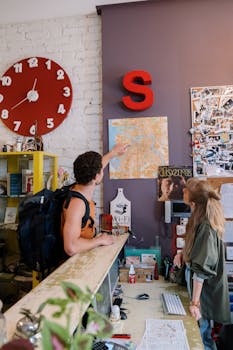Travel has evolved significantly over the past few decades, driven largely by technological advancements. Social media stands out as a prominent driver of this change across various platforms and demographics. It has become a powerful tool for inspiration, planning, and sharing experiences in the field of travel.
With the rise of social networks, travelers can now access a wealth of information right at their fingertips. Instagram, Facebook, Twitter, and others have transformed the way we discover destinations. Visual storytelling and user-generated content play crucial roles in shaping travel choices.
This article explores the multifaceted role of social media in travel. From influencing destination choices to providing real-time updates, social media has become an integral part of the travel experience.
The Influence of Social Media on Destination Discovery
Social media platforms are often the first point of contact for many travelers. They showcase beautiful images and videos that can captivate potential visitors. Friends and influencers often share their adventures, sparking interest in previously unknown locations.
Tools like Instagram and Pinterest serve as visual search engines for potential travelers. Users can create boards or feeds dedicated to their dream trips, compiling ideas on where to go, stay, and eat. This process simplifies the planning stage significantly.
Moreover, hashtags play a crucial role in categorizing content related to specific locations. Travelers can quickly find popular sites or hidden gems just by exploring specific tags. This convenience makes initial research easier and more enjoyable.
Real-time updates from social media also keep location information up to date. News, climate, or festival announcements can influence traveler decisions almost instantly. Therefore, staying connected can lead to spontaneous and exciting travel experiences.
Overall, social media facilitates a dynamic discovery process about travel destinations, making it integral to modern travel planning. This evolution highlights the need for travelers to actively engage on these platforms.
The Rise of Influencers in Travel Marketing
Travel influencers have emerged as powerful figures in the marketing landscape. They offer authentic experiences and recommendations to their followers, making travel accessible and relatable. Their impact often transcends traditional advertising.
By documenting their journeys, influencers can provide a personal touch that resonates with their audience. This connection fosters trust, and followers are more likely to consider destinations promoted by influencers they admire.
The effectiveness of influencer marketing has prompted brands and tourism boards to partner with these individuals. This strategic collaboration allows brands to reach wider audiences through familiar and relatable voices.
However, it’s vital for travelers to approach influencer content discerningly. Authenticity can vary, and the portrayal of destinations is sometimes tailored for promotional purposes. Encouraging critical thinking helps maintain a balanced perspective.
Ultimately, influencers can enhance the travel experience, offering helpful insights and advice, but travelers should remain vigilant about separating organic recommendations from paid promotions.
User-Generated Content and Its Impact
User-generated content (UGC) has transformed the travel landscape significantly. Sharing personal travel experiences through photos, reviews, and stories creates a wealth of resources. This content enhances the reputation of destinations and services.
Travel forums, blogs, and social media feeds are rich with firsthand accounts that provide real insights beyond glossy advertisements. Reviews and testimonials enable potential travelers to engage more deeply with the aspects that matter to them.
Moreover, UGC fosters a sense of community. Travelers often seek validation through sharing their experiences and interact with others who have visited the same locations. This exchange enriches the travel dialogue.
Many travel brands now actively encourage users to share their photos and stories, showcasing them on their platforms. This creates a cycle of engagement that strengthens customer loyalty and brand connect.
In conclusion, user-generated content not only expands reach but fosters trust in travel choices. This symbiotic relationship between brands and travelers ultimately shapes the travel industry’s future.
Real-Time Engagement and Immediate Feedback
Social media allows for real-time engagement between travelers and brands or tourism boards. Immediate feedback can help improve customer service and enhance the travel experience. Travelers can ask questions and receive quick responses, fostering a more interactive relationship.
Tourism boards utilize platforms to share updates, announcements, and emergency information. This level of accessibility strengthens traveler confidence and encourages last-minute trip planning. The dynamic nature of social media means information can change rapidly.
Furthermore, travelers use social media to broadcast their experiences while on the ground. Live stories and posts can inspire followers and create buzz about particular destinations. This word-of-mouth advertising is invaluable.
Travelers can also provide essential tips to fellow adventurers through reviews, comments, and posts. This reciprocal relationship enhances the community aspect of travel on social media, creating a support network.
Ultimately, the ability to engage in real-time adds immense value to the travel experience. This immediacy allows for adaptability and spontaneity that traditional mediums cannot match.
Social Media and Travel Planning
Travel planning has become more efficient thanks to social media. The platforms serve as central hubs where travelers can gather ideas, build itineraries, and share resources. These features streamline the entire process.
Many users turn to social media for personalized recommendations from peers. Travelers can easily find suggestions tailored to specific interests, be it adventure, culinary experiences, or relaxation. This personalization fosters a more fulfilling travel experience.
Additionally, social media is replete with tools and apps that streamline travel planning. From itinerary planners to budgeting tools, these resources equip users with everything they need to succeed.
Visual content facilitated by social media helps in making informed decisions. Seeing a location through the lens of fellow travelers can illuminate what to expect, leading to more realistic planning.
In essence, social media has revolutionized travel planning, making it more interactive and engaging for users. The platforms offer a plethora of tools enabling travelers to organize efficient and exciting itineraries.
Safety and Travel Awareness Through Social Media
Social media plays an essential role in promoting safety awareness for travelers. Real-time updates about travel conditions, safety alerts, or health advisories allow travelers to stay informed. This instant access can be crucial during emergencies.
Travelers often share their experiences regarding safety in different locations. Insight from fellow tourists can highlight potential risks, enabling others to make informed decisions. This community-based perspective is invaluable when exploring new destinations.
Additionally, tourism boards and safety organizations utilize social media to disseminate crucial information. By being proactive, they help ensure travelers remain safe and prepared for various situations that may arise.
Moreover, travelers can create support networks through social media groups. These communities foster open communication, allowing for the exchange of tips and strategies aimed at enhancing traveler safety.
Ultimately, the role of social media in safety awareness cannot be overstated. By sharing information swiftly and broadly, it supports more secure and enjoyable travel experiences.
Conclusion
Social media’s role in travel has been transformative, affecting how we discover, plan, and experience journeys. With the ability to engage in real-time and share personal insights, social media enriches the overall travel landscape.
Whether through influencer marketing or user-generated content, social media has democratized travel planning. It empowers travelers to make informed choices while fostering community connections worldwide.
As technology continues to evolve, social media will undoubtedly remain a driving force in the travel industry. Embracing this phenomenon will help travelers navigate their adventures smoothly and enjoyably.
To maximize this revolution, travelers must engage thoughtfully with social media. Taking a balanced approach will ensure an enriching and fulfilling travel experience.
Ultimately, social media paves the way for exciting travel opportunities, fostering exploration, connection, and unforgettable experiences.


